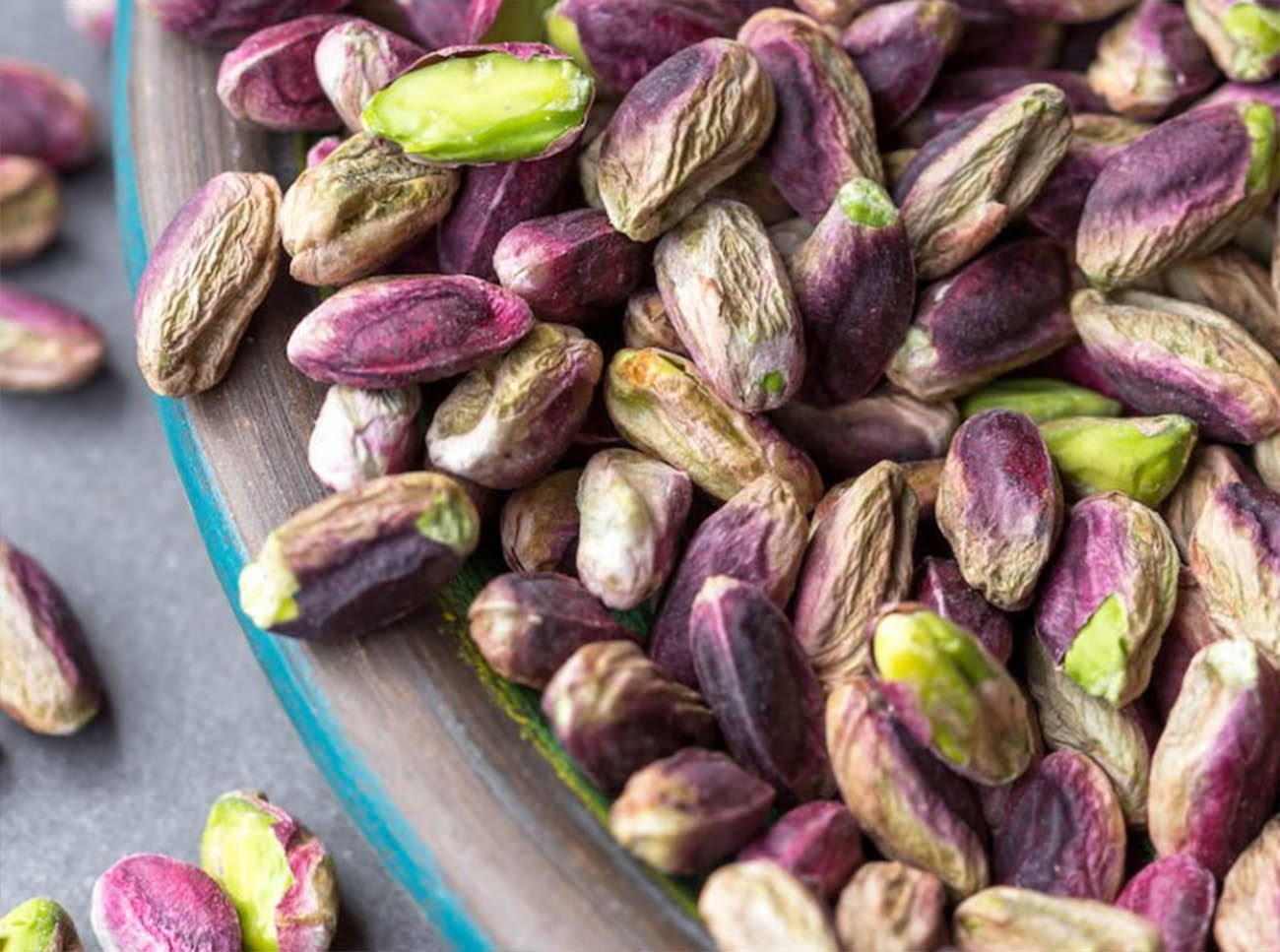
Bronte pistachio: the Sicilian green Gold
The legacy of Bronte lies not only in its pistachio but also in its history and traditions.
Among the largest municipalities in the province of Catania, Bronte, characterized by climbs and descents and born by an imperial decree promulgated in 1520 by Charles V of Habsburg, is located on the western slopes of Mount Etna, 48km from Catania, and today it has 19,172 inhabitants. Bronte is filled with ancient and elegant religious structures and its historic center has been hosting the Sagra del Pistacchio (Pistachio Festival) for centuries, which still takes place on the last Sunday of September and the first of October, in some squares and streets of the historic center of the town. During the festival, you can taste and buy the products obtained with the processing of the pistachio and the fruits themselves. Every year, the event attracts thousands of tourists also from abroad. Together with the sight of narrow streets and characteristic balconies, the Festival offers tourists a suggestive show.
The origins of the Bronte pistachio
The Bronte pistachio is a variety of pistachio that in 2009 obtained the Protected Designation of Origin (PDO). Also called Sicilian Green Gold for its high commercial value, it has its roots in the small town of Bronte and it is a food and wine product of undoubted excellence. This fruit is still cultivated on a territory characterized by the presence of hard lava rocks and then harvested by hand, as in the tradition of many decades ago. And despite its incredible international success, the Bronte pistachio continues to be loyal to local habits. It is essential to be aware of the production process and the characteristics of the fruit, so as to be able to distinguish it from other imitations that move on the market, which do not come from Bronte at all.
The legend about the name of Bronte is particular to tell: it originates in fact from the Cyclops Bronte, brother of the well-known giant of the Greek mythology Polyphemus. He inhabited the volcano of Etna and allowed the Bronte people to grow pistachios, thus earning their respect.
Pistachio is a plant native to the Mediterranean basin (Turkey and Persia) – a sea of taste, aromas, flavors, spices – which has been cultivated since ancient times for its precious seeds.
Historic area of exchange between East and West, it is precisely through the Mare Nostrum that the pistachio reaches Italy. It was the Arabs, tearing Sicily from the Byzantines in 827, who introduced pistachio to the island and to increase and equip themselves in the cultivation of the fruit which, particularly on the slopes of Etna, found the natural habitat for a luxuriant and peculiar development. Even today, in fact, the terms “frastucara” and “frastuca” are used in dialect, deriving from the Arabic words “fristach” and “frastuch”, to indicate the plant and fruit of the pistachio.
The plant found the perfect environmental conditions to settle permanently in the uncultivated volcanic soils called “sciare”, difficult to cultivate because they are steep and rich in ash. The pistachio, a resistant plant with great adaptability, conquered the skiing of that territory, where the soil naturally fertilized by the ashes of the volcano favored the production of pistachios with particular and typical organoleptic qualities of this pistachio.
The pistachios of Bronte, aromatic, tasty and of a characteristic emerald green colour, soon distinguished themselves for their properties and the cultivation of the pistachio became the most important in the area, so much so that Bronte acquired the fame of “city of pistachio” and the precious seeds began to be called “the green gold”. In 1799 the territory was donated to the English admiral Horace Nelson as a reward. Today throughout the Bronte area the pistachio groves (or ” lochi ”) cover about four thousand hectares of inaccessible land and the Bronte pistachios, used in gastronomy and pastry, are known all over the world.
The features
The Bronte pistachio owes its precious and unique characteristics to its territory: it is evident the extraordinary combination of the plant and the lava soil which, continuously fertilized by volcanic ash, gives rise to a fruit that, from the point of view of taste and aroma, surpasses the remaining world production in quality. Pistachio trees grow on rocky soils covered by volcanic lavas from Etna, at an altitude ranging between 300 and 900 meters, thus being well able to withstand both cold and drought.
Let’s see what are the main characteristics of the fruit:
• First of all, the shell has a vaguely concave and rounded shape, with the ends facing slightly upwards. Inside, it has a slightly elongated and pointed shape.
• The fruit is characterized by a thin purplish skin with green reflections. Once opened halfway, in fact, the pistachio has an emerald green color, due to the high concentration of chlorophyll. Pistachios produced in other regions, on the other hand, are decidedly more yellow internally and almost completely lack the purple color on the skin.
• The Bronte pistachio has a taste tending to sweet, delicate, aromatic and absolutely unsalted, a distinctive trait to recognize it from imitations.
• The grains are selected manually by choosing those with an open shell of at least a few millimeters, to allow the consumer to open the fruit with the fingernail and consume the product. In this sense, it is to be eaten fresh, without roasting or salting.
The production and cultivation process
In Bronte and generally in Sicily, the pistachio is also known by the vulgar name of “Spaccasassi” (for its developed and deep root system that is well suited to rocky soils) or “Cornucopia” (for the hardness of its wood superior to the horn of beak), or even with the name “Scornabeccu” (for the galls, shaped like a goat horns, which develop on its leaves; the term derives from the Spanish cornicabra, goat horn, with the same meaning).
The cultivation and production of pistachio represent an important source of income for Bronte. The city has in fact been able to exploit this advantage, so much so that in its territory there are about 5000 producers, most of them with plots of about 1 hectare each, as well as some large producers with a multiple of hectares. The harvested fruit is generally hulled and dried by the producer himself, who then sells his pistachio in shell to exporting companies: about 60% is exported abroad, while 40% is used in national industry. There are about twenty pistachio processing companies, some of them well equipped and technologically advanced, which deal with the subsequent processing and marketing in Europe and in other non-European countries.
The Bronte pistachio PDO is grown, as well as in the municipality of Bronte, in those of Adrano and Biancavilla at precise heights and soils indicated in the DOP specification, between 400 and 900 m a.s.l. In numerical terms, it represents over 90% of the Italian pistachio production and about 2% of the world production. In Bronte, moreover, an infinite variety of products derived from processed pistachio are produced, such as the famous pistachio pesto sauce for pasta, pistachio ice cream, pistachio biscuits, pistachio cream, pistachio chocolate and more.
The harvest
The harvest, which involves the entire population, takes place at the end of the summer, between the end of August and the beginning of October, but only every other year, so as to allow the plant to rest and resist more atmospheric agents: one year the harvest, the following year the buds are eliminated to protect the plant.
In particular, the fruit is harvested by hand, as it did decades ago, especially taking into account that the ground is somewhat uneven and it would be practically impossible to use a machine between one plant and another.
Once harvested, the fruits are taken to the houses located among the pistachio groves and spread on gigantic cloth sheets, to then be left to dry in the sun still covered by the husk, at about 40 ° C to eliminate humidity. Towards the end of the drying phase, the husk is removed and the pistachios left to dry in the sun, after which the seeds can be shelled or not and stored in cool and dry places, storing them in paper or jute bags waiting to be packaged and marketed. And it is in this way that the Bronte pistachio is produced, an Italian excellence which, thanks to its unique organoleptic characteristics, is appreciated all over the world for its aromatic flavor that gives flavor to sweet and savory recipes.
Usage and benefits
Pistachios are used in many ways in the kitchen: to flavor drinks and various dishes, as dried fruit used to flavor salami, mortadella, pistachio salami, produced by some Sicilian companies, but also to make brontese pesto or the tasty cream suitable for any filling, the famous Pistacchiella. The Bronte pistachio triumphs in the confectionery industry in nougat, mousses, sugared almonds and it is highly sought after by the artisans of ice cream. Tourists can try a boundless variety of excellences in the many restaurants in the area, among which we recommend the penne with pistachio and clams, pistachio risotto and salmon in pistachio sauce.
The cardiovascular system benefits the most from consuming Bronte pistachio, as it helps to counteract many risk factors, including type 2 diabetes. Not only that: the particular composition of pistachio fats, together with the richness of fiber, helps modulating postprandial glycaemia and maintain the lipid profile in the normal range.
The World Health Organization (WHO) recommends 30g of pistachios, perhaps as a snack. Among the various types of dried fruit, it is among the least caloric and with a greater number of seeds per serving.


